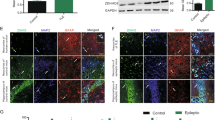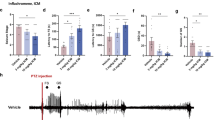Abstract
GSK-126 is recognized as an inhibitor of enhancer of zeste homolog-2 (EZH2) activity. Because of its inhibition of EZH2 activation, GSK-126 is considered a potential anti-tumor drug. EZH2 is a histone methyltransferase that catalyzes histone 3 tri-methylation at lysine 27 (H3K27me3), resulting in gene silencing. A previous report showed that decreased H3K27me3 levels in the hippocampus may promote seizure susceptibility, possibly restricting the clinical application of GSK-126. The role of GSK-126 in seizure susceptibility was investigated in this study. We first determined a critical concentration of pentamethazol (PTZ) under which mice exhibit no seizures. We then found that mice pretreated with GSK-126 and injected with the same concentration of PTZ experienced marked convulsions. Peripheral injections of GSK-126 decreased H3K27me3 levels in the hippocampus of mice, while some seizure-related genes (Oasl1, Sox7, armcx5, Ncx3, etc.) were found to be differentially expressed in the hippocampus of those mice . These differences in the expression levels might reflect the crucial role of these genes and related pathways in the promotion of seizure susceptibility. Our results suggest that GSK-126 promotes seizure susceptibility due to its role as an EZH2 inhibitor. These findings may provide evidence to support the development of GSK-126 as a clinical drug.






Similar content being viewed by others
Data Availability
We declared that materials described in the manuscript, including all relevant raw data, will be freely available to any scientist wishing to use them for non-commercial purposes, without breaching participant confidentiality.
References
Akizu N, Estaras C, Guerrero L, Marti E, Martinez-Balbas MA (2010) H3K27me3 regulates BMP activity in developing spinal cord. Development (Cambridge, England) 137:2915–2925. https://doi.org/10.1242/dev.049395
Chen YT, Zhu F, Lin WR, Ying RB, Yang YP, Zeng LH (2016) The novel EZH2 inhibitor, GSK126, suppresses cell migration and angiogenesis via down-regulating VEGF-A. Cancer Chemother Pharmacol 77:757–765. https://doi.org/10.1007/s00280-016-2990-1
Dhir A (2012) Pentylenetetrazol (PTZ) kindling model of epilepsy. Curr Protoc Neurosci Chapter 9:Unit9.37. https://doi.org/10.1002/0471142301.ns0937s58
Fioravanti R, Stazi G, Zwergel C, Valente S, Mai A (2018) Six years (2012-2018) of researches on catalytic EZH2 inhibitors: the boom of the 2-pyridone compounds. Chem Rec (New York, NY) 18:1818–1832. https://doi.org/10.1002/tcr.201800091
Gürol G, Demiralp DÖ, Yılmaz AK, Akman Ö, Ateş N, Karson A (2015) Comparative proteomic approach in rat model of absence epilepsy. J Mol Neurosci 55:632–643. https://doi.org/10.1007/s12031-014-0402-8
Henriquez B, Bustos FJ, Aguilar R, Becerra A, Simon F, Montecino M, van Zundert B (2013) Ezh1 and Ezh2 differentially regulate PSD-95 gene transcription in developing hippocampal neurons. Mol Cell Neurosci 57:130–143. https://doi.org/10.1016/j.mcn.2013.07.012
Kang TC, An SJ, Park SK, Hwang IK, Suh JG, Oh YS, Bae JC, Won MH (2002) Alterations in Na+/H+ exchanger and Na+/HCO3- cotransporter immunoreactivities within the gerbil hippocampus following seizure. Brain Res Mol Brain Res 109:226–232. https://doi.org/10.1016/s0169-328x(02)00559-4
Kleer CG, Cao Q, Varambally S, Shen R, Ota I, Tomlins SA, Ghosh D, Sewalt RGAB, Otte AP, Hayes DF, Sabel MS, Livant D, Weiss SJ, Rubin MA, Chinnaiyan AM (2003) EZH2 is a marker of aggressive breast cancer and promotes neoplastic transformation of breast epithelial cells. Proc Natl Acad Sci U S A 100:11606–11611. https://doi.org/10.1073/pnas.1933744100
Li X, Giri V, Cui Y, Yin M, Xian Z, Li J (2019) LncRNA FTX inhibits hippocampal neuron apoptosis by regulating miR-21-5p/SOX7 axis in a rat model of temporal lobe epilepsy. Biochem Biophys Res Commun 512:79–86. https://doi.org/10.1016/j.bbrc.2019.03.019
Liu H, Peng L, So J, Tsang KH, Chong CH, Mak PHS, Chan KM, Chan SY (2018) TSPYL2 regulates the expression of EZH2 target genes in neurons. Mol Neurobiol 56:2640–2652. https://doi.org/10.1007/s12035-018-1238-y
McCabe MT et al (2012) EZH2 inhibition as a therapeutic strategy for lymphoma with EZH2-activating mutations. Nature 492:108–112. https://doi.org/10.1038/nature11606
Momparler RL, Cote S, Momparler LF, Idaghdour Y (2017) Inhibition of DNA and histone methylation by 5-aza-2’-deoxycytidine (decitabine) and 3-deazaneplanocin-A on antineoplastic action and gene expression in myeloid leukemic cells. Front Oncol 7:19. https://doi.org/10.3389/fonc.2017.00019
Racine RJ (1972) Modification of seizure activity by electrical stimulation. II Motor seizure. Electroencephalogr Clin Neurophysiol 32:281–294
Rassner MP, Moser A, Follo M, Joseph K, van Velthoven-Wurster V, Feuerstein TJ (2016) Neocortical GABA release at high intracellular sodium and low extracellular calcium: an anti-seizure mechanism. J Neurochem 137:177–189. https://doi.org/10.1111/jnc.13555
Schubert HL, Blumenthal RM, Cheng X (2003) Many paths to methyltransfer: a chronicle of convergence. Trends Biochem Sci 28:329–335. https://doi.org/10.1016/s0968-0004(03)00090-2
Sun D, Ma H, Ma J, Wang J, Deng X, Hu C, Deng X (2018) Canonical transient receptor potential channel 3 contributes to febrile seizure inducing neuronal cell death and neuroinflammation. Cell Mol Neurobiol 38:1215–1226. https://doi.org/10.1007/s10571-018-0586-5
Varambally S, Dhanasekaran SM, Zhou M, Barrette TR, Kumar-Sinha C, Sanda MG, Ghosh D, Pienta KJ, Sewalt RGAB, Otte AP, Rubin MA, Chinnaiyan AM (2002) The polycomb group protein EZH2 is involved in progression of prostate cancer. Nature 419:624–629. https://doi.org/10.1038/nature01075
Varambally S et al (2008) Genomic loss of microRNA-101 leads to overexpression of histone methyltransferase EZH2 in cancer. Science (New York, NY) 322:1695–1699. https://doi.org/10.1126/science.1165395
Vezzani A, French J, Bartfai T, Baram TZ (2011) The role of inflammation in epilepsy. Nat Rev Neurol 7:31–40. https://doi.org/10.1038/nrneurol.2010.178
Wang Z, Fan Y, Xu J, Li L, Heng D, Han S, Yin J, Peng B, Liu W, He X (2014) Transcriptome analysis of the hippocampus in novel rat model of febrile seizures. PLoS One 9:e95237. https://doi.org/10.1371/journal.pone.0095237
Wang Z, Zhang Y, Fang J, Yu F, Heng D, Fan Y, Xu J, Peng B, Liu W, Han S, He X (2017) Decreased methylation level of H3K27me3 increases seizure susceptibility. Mol Neurobiol 54:7343–7352. https://doi.org/10.1007/s12035-016-0197-4
Yadav R, Weng HR (2017) EZH2 regulates spinal neuroinflammation in rats with neuropathic pain. Neuroscience 349:106–117. https://doi.org/10.1016/j.neuroscience.2017.02.041
Zeng D, Liu M, Pan J (2017) Blocking EZH2 methylation transferase activity by GSK126 decreases stem cell-like myeloma cells. Oncotarget 8:3396–3411. https://doi.org/10.18632/oncotarget.13773
Zhang P, de Gooijer MC, Buil LC, Beijnen JH, Li G, van Tellingen O (2015) ABCB1 and ABCG2 restrict the brain penetration of a panel of novel EZH2-Inhibitors. Int J Cancer 137:2007–2018. https://doi.org/10.1002/ijc.29566
Zhou J, Goldberg EM, Leu NA, Zhou L, Coulter DA, Wang PJ (2014) Respiratory failure, cleft palate and epilepsy in the mouse model of human Xq22.1 deletion syndrome. Hum Mol Genet 23:3823–3829. https://doi.org/10.1093/hmg/ddu095
Funding
This work was financially supported by the National Natural Sciences Foundation of China (grant numbers 81801168, 81802063); the Natural Sciences Foundation of Jiangsu Province (grant number BK20160228); the Natural Science Foundation of the Jiangsu Higher Education Institutions (grant number 18KJB320026); and the Starting Foundation for Talents of Xuzhou Medical University (grant number D2017022).
Author information
Authors and Affiliations
Contributions
ZW and TL conceived and designed the original study. ZW and YS conducted the statistical analysis and drafted the manuscript. YS and DZ contributed to the acquisition and interpretation of data. ZW and TL participated in critical revision of the manuscript. All authors read and approved the final manuscript.
Corresponding authors
Ethics declarations
Competing Interests
The authors declare that they have no competing interests.
Ethics Approval
All animal procedures were approved by the Committee on the Ethics of Animal Experiments of the Xuzhou Medical University (China).
Consent to Participate
Not applicable.
Consent for Publication
Not applicable.
Additional information
Publisher’s Note
Springer Nature remains neutral with regard to jurisdictional claims in published maps and institutional affiliations.
Electronic Supplementary Material
Supplement Fig. 1
The Vocalno Plot of different expressed genes. Vocalno Plot indicated up-regulated and down-regulated genes between the GSK-126 and control groups. Up-regulated and down-regulated genes were colored in red and blue, respectively. (PNG 248 kb)
ESM 2
(DOCX 17 kb)
ESM 3
(DOCX 16 kb)
ESM 4
(DOCX 33 kb)
ESM 5
(DOC 31 kb)
ESM 6
(XLSX 148 kb)
ESM 7
(XLSX 83 kb)
ESM 8
(XLSX 45 kb)
ESM 9
(MP4 19559 kb)
ESM 10
(MP4 21000 kb)
Rights and permissions
About this article
Cite this article
Wang, Z., Su, Y., Zhuang, D. et al. The Role of EZH2 Inhibitor, GSK-126, in Seizure Susceptibility. J Mol Neurosci 71, 556–564 (2021). https://doi.org/10.1007/s12031-020-01677-7
Received:
Accepted:
Published:
Issue Date:
DOI: https://doi.org/10.1007/s12031-020-01677-7




